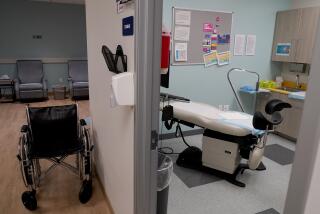Planned Parenthood and the cynical attack on fetal tissue research

Supporters of Planned Parenthood rallied last month in Salt Lake City, where Utah Gov. Gary Herbert is aiming to stop disbursing federal money to the women’s health organization.
As with all orchestrated uproars, the current political attack on Planned Parenthood employs distraction and misdirection to keep people from focusing attention on facts and reality. In this case, the distraction involves an attack on the use of fetal tissue in medical research, which may well become collateral damage in the campaign against Planned Parenthood.
If that happens, it would warrant our moral outrage. It’s time to set the record straight.
The prominent bioethicist R. Alta Charo of the University of Wisconsin does so incisively in the current issue of the New England Journal of Medicine.
“We have a duty to use fetal tissue for research and therapy,” she writes. “And that duty includes taking advantage of avenues of hope for current and future patients, particularly if those avenues are being threatened by a purely political fight.”
As Charo notes, the campaign of distorted videos mounted against Planned Parenthood by the inaptly named Center for Medical Progress aims to depict fetal tissue research as the unholy beneficiary of induced abortions. It’s a convenient target, for there’s no question that fetal tissue research exists, and that some of the tissue comes from abortions. But that’s where the reality ends and the sophistry begins.
Charo walks us through the techniques and history of the attack. A key is to twist the language to distort the work, portraying it as “ghoulish vivisection and body-part snatching.” (In an earlier op-ed for the Washington Post, she points out that the anti-abortion lobby uses such terms as “‘harvest’ (as opposed to ‘recover’)” to describe the process of obtaining the tissues, the better to depict the process as callous.
Yet what’s commonly overlooked is the value of this research for medical science.
“Virtually every person in this country has benefited from research using fetal tissue,” Charo writes. “Every child who’s been spared the risks and misery of chickenpox, rubella, or polio can thank the Nobel Prize recipients and other scientists who used such tissue in research yielding the vaccines that protect us (and give even the unvaccinated the benefit of herd immunity). This work has been going on for nearly a century, and the vaccines it produced have been in use nearly as long. Any discussion of the ethics of fetal tissue research must begin with its unimpeachable claim to have saved the lives and health of millions of people.”
Members of the anti-abortion lobby “have overwhelmingly partaken of the vaccines and treatments derived from fetal tissue research and give no indication that they will forswear further benefits. Fairness and reciprocity alone would suggest they have a duty to support the work, or at least not to thwart it.”
Some history is instructive here. This is not the first time that an attack on fetal tissue research has been used as a wedge against abortion rights. The same thing happened after the Supreme Court’s 1973 decision in Roe v. Wade. “Right-to-life leaders seized upon fetal research as an issue,” wrote Rachel Benson Gold of the Alan Guttmacher Institute in 1989, “arguing that using fetal tissue obtained from induced abortions...was an extension of a so-called ‘abortion mentality’ that ‘dehumanized’ the fetus.”
Their campaign deeply politicized the research, as may well happen today. What followed was a series of federal moratoriums in 1974-75 and 1988-93, each one ending after a blue-ribbon advisory committee judged the research morally defensible and recommended safeguards.
The most important committee was convened by the National Institutes of Health in 1988, during the Reagan administration. The panel included several abortion opponents, including its chairman, retired U.S. Judge Arlin M. Adams of Philadelphia, but nevertheless voted overwhelmingly in favor of allowing fetal tissue research, with appropriate conditions.
These were, chiefly, that the decision by a woman to donate the tissue of an aborted fetus remain separate from, and subsequent to, the decision to undergo the abortion; that tissue donations for transplantation into specific persons, including family members, be barred; and that no payments be allowed beyond the recovery of costs.
These rules are still in place. And despite the efforts of Center for Medical Progress’ agents to coax or goad Planned Parenthood officials into flouting them on videotape, their targets upheld those principles at every step. And that’s on videotape.
One big concern of the 1988 panelists was whether the prospect of donating tissue for medical research would induce women who might not otherwise choose abortion to do so. There was absolutely no evidence that this had happened in the past. Commission member John D. Robertson, a University of Texas law professor, called it a “hypothetical fear.” He wrote: “The panel heard no convincing evidence that a pregnant woman’s decision against abortion would be changed by the prospect of anonymous tissue donation.” The recommended safeguards, he added, would make that prospect even more remote.
Nevertheless, he continued, “opponents would ban all federally supported fetal tissue research... out of the hypothetical fear, which the Panel has rejected, that abortions will increase.”
Yet fetal tissue research remained politicized for years more. Interestingly, the effort to overturn the moratorium was bipartisan, for many abortion foes in Congress viewed fetal tissue donations as “life-affirming”; in 1992, legislation to reverse the ban was pushed by GOP Sens. Bob Dole of Kansas and John Danforth of Missouri, among others.
Rep. Fred Upton, R-Mich -- one of the lawmakers who harassed Planned Parenthood partner StemExpress over the Center for Medical Progress’ deceptive videos -- even went to the White House to talk President George H.W. Bush out of continuing the ban. It was finally ended by President Clinton, by executive order in 1993.
Fetal tissue research is once again in the political crosshairs, despite indisputable evidence that it saves lives.
“It seems clear that the needs of current and future patients outweigh what can only be symbolic or political gestures of concern,” Charo writes. “Fetal tissue research has already led to investigational therapy for end-stage breast cancer and advances against cardiac causes, and transplantation research is actively being pursued for diabetes (using fetal pancreatic islet cells), amyotrophic lateral sclerosis (using neural fetal stem cells injected into the spine), and in a major European initiative, Parkinson’s disease (using fetal dopamine cells).” The first polio vaccine was based on cultures of human fetal cells, which were also crucial factors in the development of the rubella vaccine, which helped to wipe out a disease that caused countless birth defects in the children of women infected during pregnancy.
The campaigners against Planned Parenthood, seeking nothing but a political pelt to hang on their wall, would place all such research at risk. “Abortion opponents have added millions of people to the collateral damage of the abortion war,” Charo writes, calling it “a betrayal of the people whose lives could be saved by the research and a violation of that most fundamental duty of medicine and health policy, the duty of care.”
Keep up to date with the Economy Hub. Follow @hiltzikm on Twitter, see our Facebook page, or email michael.hiltzik@latimes.com.







